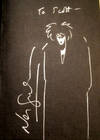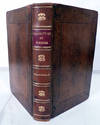
Ironia e piedade.
by BILAC, Olavo [Braz Martins dos Guimarães]
- Used
- Hardcover
- Signed
- first
- Condition
- See description
- Seller
-
New York, New York, United States
Payment Methods Accepted
About This Item
Rio de Janeiro, São Paulo & Belo Horizonte, Livraria Francisco Alves, 1916.. First Edition in Book Form. 8°, contemporary cat's-paw sheep (slight outward warping to covers), spine gilt with raised bands in five compartments, citron leather lettering piece in second compartment from head, gilt letter, marbled endleaves, text-block edges rouged, original gray printed wrappers (minor fading) bound in. In fine condition. Half-title has signed four-line ink inscription dated 1916 from Olavo Bilac to Carlos Malheiro Dias, the well-known Portuguese novelist, historian, essayist and dramatist. Bookplate of Malheiro Dias on front free endpaper. 288 pp.; quire 15 is of 7 (rather than 8) leaves, and the pagination skips pp. 237-8, but the text appears to be complete. ***
First Edition in Book Form of these 52 short essays, most of which appeared previously in the Gazeta de noticias of Rio de Janeiro. The second edition appeared in Rio, 1921, the third in Rio, 1926. Among the subjects of the essays are China, Jules Verne, Carnaval, the Boers, electricity, Erasmus, and graphology. On pages 175-8 is an essay on tuberculosis and public health.
Bilac, Raimundo Correia, Alberto de Oliveira, and Vicente de Carvalho were the four major poets of the Brazilian Parnassian school, which reacted against the excesses of Romanticism beginning in the 1870s. Of these four, the critics preferred Correia, but the public favored Bilac, and he was often referred to as the "Prince of Brazilian poets." In the years immediately following his death, before Modernism took hold, Bilac was the most widely read and imitated Brazilian poet, and even the Modernists - reacting in their turn against precisely the sort of things Bilac stood for - could not condemn his work completely. Jong wrote that "His impeccable poems are fluent, brilliant and full of passion.… But in spite of his meticulous workmanship, his poems always remain natural, simple and correct" (400 Years, p. 398).
Bilac (1865-1918), a native of Rio de Janeiro, began but did not complete courses in medicine and law; instead he decided to devote himself to literature, and from his home in Rio de Janeiro began contributing extensively to periodicals. His first poems appeared in the Gazeta Acadêmica in 1883. His first published book was Poesias 1884-1887, São Paulo, 1888. Major works following the appearance of Poesias include Crônicas e novelas (1894), Sagres (1898), an expanded edition of Poesias (1902), and Tarde, published posthumously in 1919. In the last years of his life Bilac lectured throughout Brazil on national defense, specifically advocating compulsory military service. He was a charter member of the Academia Brasileira de Letras.
Provenance: The writer Carlos Malheiro Dias (Porto, 1875-Lisbon, 1941), whose mother was Brazilian and who lived much of his youth in Rio de Janeiro, returned to Brazil several times as an adult. See Álvaro Manuel Machado in Dicionário de literatura portuguesa, pp. 163-4; João Bigotte Chorão in Biblos, II, 122-4; and Dicionário cronológico de autores portugueses, pp. 164-7.
*** Menezes, Dicionário literário brasileiro pp. 112-3. Ford, Whittem and Raphael, Tentative Bibliography of Brazilian Belles-Lettres, p. 29. On the author, see Carpeaux, Pequena bibliografia crítica da literatura brasileira p. 172; Bandeira, Brief History of Brazilian Literature pp. 109, 111; Veríssimo, História da literatura brasileira pp. 243 and elsewhere; and Nossos Clássicos 2. Not located in Porbase, which lists only a single copy of the third edition (1926), at Biblioteca João Paulo II-Universidade Católica Portuguesa. Jisc locates a single copy, at Glasgow University. NUC: DLC; Rio, 1921 edition at MB and MH; Rio, 1926 at OCl, MH, CU.
Reviews
(Log in or Create an Account first!)
Details
- Bookseller
- Richard C. Ramer Old & Rare Books
(US)
- Bookseller's Inventory #
- 20450
- Title
- Ironia e piedade.
- Author
- BILAC, Olavo [Braz Martins dos Guimarães]
- Book Condition
- Used
- Edition
- First Edition in Book Form
- Binding
- Hardcover
- Publisher
- Rio de Janeiro, São Paulo & Belo Horizonte, Livraria Francisco Alves, 1916.
- Weight
- 0.00 lbs
- Keywords
- Brazilian natives, Rio de Janeiro natives, literature, China, Jules Verne, Carnaval, the Boers, electricity, Erasmus, graphology, public health, medicine, tuberculosis, science, literature, Carlos Malheiro Dias, Afro-Brazilian author
Terms of Sale
Richard C. Ramer Old & Rare Books
30 day return guarantee, with full refund including shipping costs for up to 30 days after delivery if an item arrives misdescribed or damaged.
About the Seller
Richard C. Ramer Old & Rare Books
Biblio member since 2012
New York, New York
About Richard C. Ramer Old & Rare Books
We have been in business since 1969. We work from private premises, both in New York and in Lisbon, Portugal, and admit visitors by appointment. Online lists are issued regularly.
Glossary
Some terminology that may be used in this description includes:
- Leaves
- Very generally, "leaves" refers to the pages of a book, as in the common phrase, "loose-leaf pages." A leaf is a single sheet...
- Wrappers
- The paper covering on the outside of a paperback. Also see the entry for pictorial wraps, color illustrated coverings for...
- Raised Band(s)
- Raised bands refer to the ridges that protrude slightly from the spine on leather bound books. The bands are created in the...
- First Edition
- In book collecting, the first edition is the earliest published form of a book. A book may have more than one first edition in...
- Fine
- A book in fine condition exhibits no flaws. A fine condition book closely approaches As New condition, but may lack the...
- Gilt
- The decorative application of gold or gold coloring to a portion of a book on the spine, edges of the text block, or an inlay in...
- Edges
- The collective of the top, fore and bottom edges of the text block of the book, being that part of the edges of the pages of a...
- Bookplate
- Highly sought after by some collectors, a book plate is an inscribed or decorative device that identifies the owner, or former...
- Spine
- The outer portion of a book which covers the actual binding. The spine usually faces outward when a book is placed on a shelf....



